
Superheroes come in many different guises, ranging from the traditional caped crusaders such as Spiderman, Superwoman and Batman to modern-day action heroes such as Power Rangers and Tree Fu Tom. When engaged in this form of imaginary play, children often use costumes and props or small-world figures to imitate characters or action heroes they admire.
According to Dr Kay Mathieson, early years consultant and trainer, children use this play as a means to work out situations where good and bad can be explored, defined and resolved. She adds, ‘Developmentally, they are exploring their thinking and understanding about dilemmas, competing priorities and confusion around “grey areas” between good and bad. In addition, they are learning about people and the range of intentions that might give rise to particular behaviours or actions.’
BISH, BASH, BOSH
One of the difficulties for practitioners is that superhero play can appear as just a process of ‘bish, bash, bosh’, explains Dr Mathieson, ‘without any obvious progress happening’.
She adds, ‘The essential element is that the adults understand, value and respect the play with its associated learning. This includes finding out as much as you can about the facts about each character and how they use their superhero powers and status.’
Dr Mathieson advises practitioners to watch the TV series Tree Fu Tom because the storylines contain explicit moral and emotional issues about friendship and leadership that can be fed into some of the storylines of more popular superheroes.
The character of Tree Fu Tom, which appeals particularly to three- and four-year-olds, was designed to raise awareness of dyspraxia. In order for his powers to work, the audience must perform a set of moves devised to cross the mid-point.
‘One of the key things about this series is that there’s a very clear demarcation between the real boy and the cartoon version of him, so that children understand the link into pretend play,’ highlights Dr Mathieson.
Having more insight into the characters that children are acting out will also help practitioners to intervene in a sensitive, knowledgeable way, which can impact positively on the play. ‘If we’re aware of the moral principles of certain superheroes – for example, the fact that Batman, Spiderman and Superman don’t ever kill anyone – we can support the children to challenge their storyline,’ she says.
‘So, if a group of children are playing superheroes and the play turns into bish bash bosh, and when you go over to intervene the child says, “I’m killing him because he’s a baddy”, you can respond, “But Superman doesn’t do that. What does he do instead?” The practitioners can then introduce problem-solving and moving their thinking forward.’
SUPPORTING ROLE
Superhero play is also being demonstrated by younger children, perhaps as a result of more group childcare experience and greater access to TV and film. Young children naturally look to those bigger and older to learn more. However, developmentally, our twos and threes are ‘not yet ready to play out’ some of the more complex aspects of moral awareness that is characteristic of superhero play, Dr Mathieson reports.
She adds, ‘Equally some older children need help to recognise some of the play structures that are shown in the stories depicted in comics and TV and film.’
KEY POINTS
Find out about the moral principles, characters and typical situations related to the superhero your children are engaged with.
Support children to set up the play – working out who will be the goodies and baddies.
Support children to recognise how the superhero sticks with their moral principle no matter what.
Help children to find a resolution to their play before tidy-up time.
Remember it is their play and should be fun.
RESOURCES
Dr Mathieson urges settings to resist having children come to nursery dressed in Superman and Spiderman costumes and advocates the use of open-ended, flexible materials where children can make their own superhero outfits and accessories. These can include lengths of fabric and junk materials that children can use to make their own capes, wea pons or magic wands and help them to create their fantasy scenarios.
pons or magic wands and help them to create their fantasy scenarios.
Here are some resources to support superhero role play:
Commercially produced superhero costumes tend to limit children’s play, so when buying role-play costumes, opt for accessories such as capes or cuffs that provide starting points to stimulate the imagination. Try the set of four Glitzy Superhero Capes, £24.99, from www.cosydirect.com. The Role Play Superhero Dress Up Set, £49.95 – a set of three outfits which each includes a cape, mask and pair of gauntlets – and the Dress up Superhero Reversible Capes and Masks, £49.95, are both available from www.tts-group.co.uk. Or try the Bat Cape and Mask and the Spider Cape and Mask, both £23.95, from www.earlyexcellence.co.uk.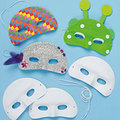
Try using empty cardboard rolls to create superhero cuffs that the children can decorate. Or, try the set of four Superheroes Cuffs, £11.99, from www.cosydirect.com, which are designed for open-ended, non-gender-specific use.
Masks are useful accessories in superhero play. Help children make their own or buy a set of 24 Flocked Eye Masks, £8.40, from www.bakerross.co.uk, that children can decorate themselves. Alternatively, try the set of 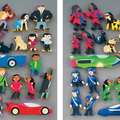 three Superhero Masks, £5.99, from www.cosydirect.com.
three Superhero Masks, £5.99, from www.cosydirect.com.
Supplement your superhero play with Fibre Optic Torches, £5.99 for three, from www.reflectionsonlearning.co.uk.
For small-world play, try the Superhero Play Collection, £95, from www.earlyexcellence.co.uk, and the Come Alive Superheroes Wooden Characters, £40, available through www.yellow-door.net. Or www.tts-group.co.uk has a set of 10 Small World Superhero Figures, priced £27.95.
For books, try the set of three Superhero Story Book Set, £20.95, from www.earlyexcellence.com.
CASE STUDY: CROCODOODLE CREATIVE PRE-SCHOOL
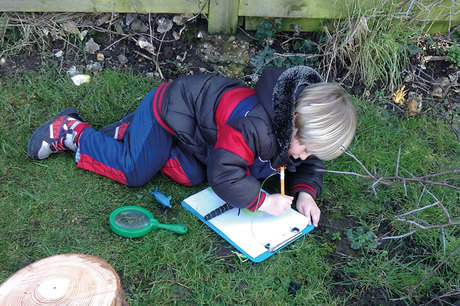
‘Last year, we had quite a lot of four-year-old boys who were interested in superhero play and used to just run around the playground chasing and shooting each other,’ explains Maria Oldfield, director of Crocodoodle Creative Pre-school in Shoreham-by-Sea, West Sussex.
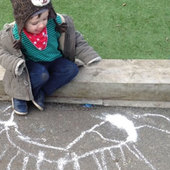 ‘We realised that we needed a strategy to make this form of play more productive and tone it down so that it wasn’t so intimidating for the younger children. After some specific training in superhero play, we began to engage with the boys about their play: asking questions about the characters; who the goodies and baddies were; what they might be feeling and trying to come up with solutions to some of the problems they might be facing that didn’t involve “killing” each other.
‘We realised that we needed a strategy to make this form of play more productive and tone it down so that it wasn’t so intimidating for the younger children. After some specific training in superhero play, we began to engage with the boys about their play: asking questions about the characters; who the goodies and baddies were; what they might be feeling and trying to come up with solutions to some of the problems they might be facing that didn’t involve “killing” each other.
‘The children mainly liked to play Spiderman and Batman, but some were interested in the Octonauts so were introduced to small-world Octonaut figures. The children began to take on the characters in their play and fight to save the endangered animals. This activity really caught their attention and became a theme for a few months.
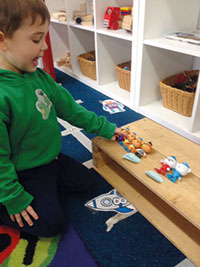 ‘In fact, over the Christmas period, the baby Jesus went missing from the crib in the nativity scene. One child declared, “The Octonauts will find him”, and the children went on a mission to hunt for baby Jesus, who was found in the dressing-up box. We didn’t invest in any special costumes for Octonaut play. The children used the builders’ goggles for diving goggles and just used pieces of fabric to create scenes of the sea.
‘In fact, over the Christmas period, the baby Jesus went missing from the crib in the nativity scene. One child declared, “The Octonauts will find him”, and the children went on a mission to hunt for baby Jesus, who was found in the dressing-up box. We didn’t invest in any special costumes for Octonaut play. The children used the builders’ goggles for diving goggles and just used pieces of fabric to create scenes of the sea.
‘During this time, we found that the children learnt how to solve problems and work together to reach a solution. Their running and chasing had a purpose and they began to engage enthusiastically with mark-making activities like drawing and writing names for the creatures and creating “missing” posters. We realised that by using and focusing their interest in superhero play, we could help them achieve much more in so many areas of learning.’
MORE INFORMATION
‘All about… superhero play’ by Nicole Weinstein, Nursery World, 19 September 2011
Dr Kay Mathieson runs superhero play training, www.kaymathieson.co.uk









